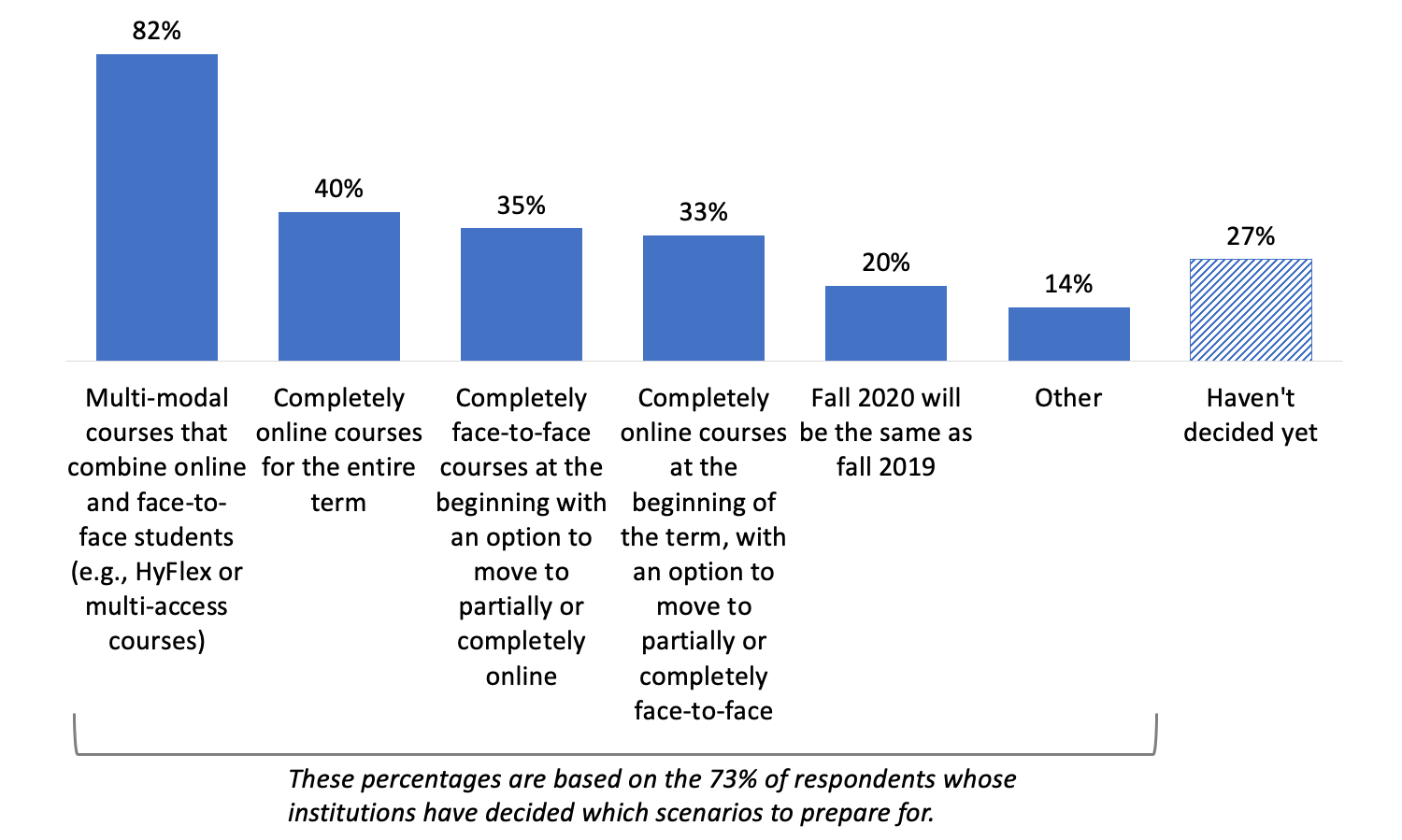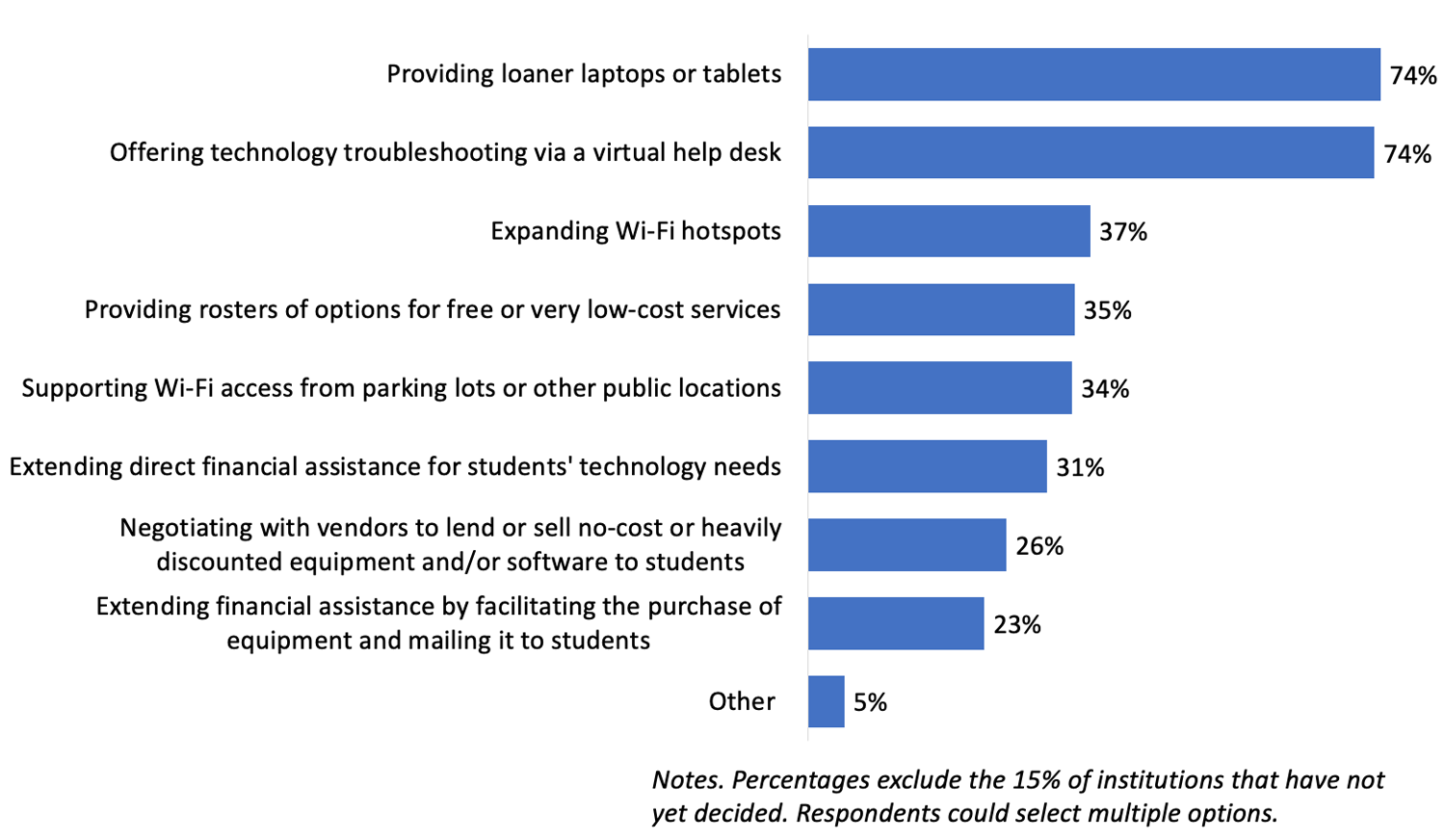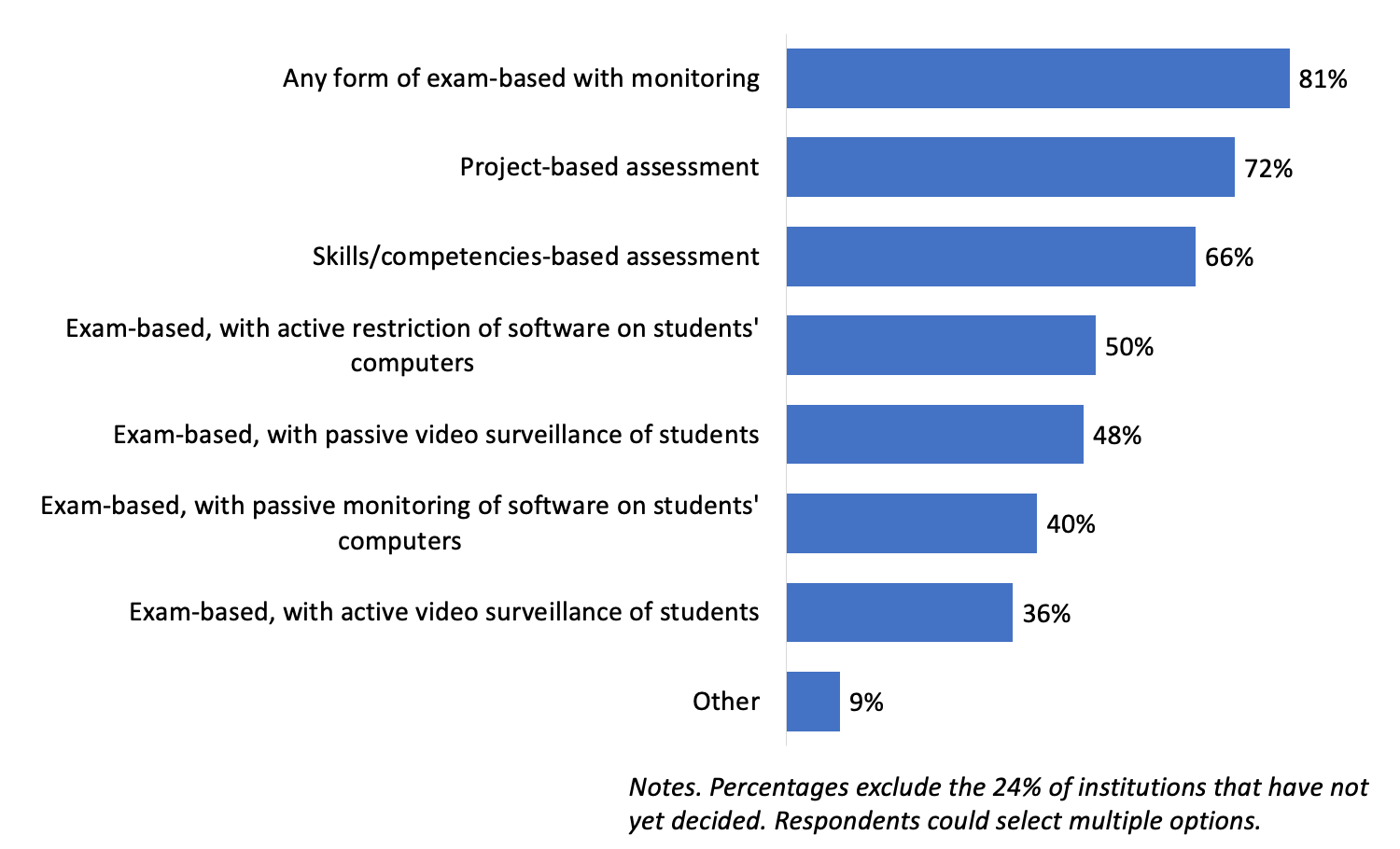As challenging as the current academic term has become, colleges and universities are facing an even longer list of unanswered questions and daunting obstacles for the fall.

As the COVID-19 pandemic upends higher education in 2020, institutions are relying on digital alternatives to missions, activities, and operations. Challenges abound. EDUCAUSE is helping institutional leaders, IT professionals, and other staff address their pressing challenges by sharing existing data and gathering new data from the higher education community. This report is based on an EDUCAUSE QuickPoll. QuickPolls enable us to rapidly gather, analyze, and share input from our community about specific emerging topics.1
The Challenge
The false hopes of a restoration to normality by the fall are giving way to the growing realization that our lives will be stunted by the pandemic for quite some time to come. Colleges and universities are struggling to adapt to a threat that seems almost perfectly designed to test all of higher education's inherent soft spots: shoestring budgets, consensus-driven planning, faculty autonomy, high-touch student support, legacy infrastructure and technology, and a high-density learning and living environment. Uncertainty is the only certainty, and many on the front lines of preparation are looking to institutional leaders and state and federal governments for guidance and decisions that have yet to appear. How can technology and teaching and learning professionals prepare for a fall term that is getting nearer and nearer with so much uncertainty and so many challenges?2
The Bottom Line
Institutions are preparing for a range of teaching scenarios this fall. HyFlex—multi-modal courses that combine online and face-to-face students—offers a great deal of flexibility and is the most common teaching scenario under preparation. Few institutions have determined whether their residence halls will be open and, if so, at what capacity, but those that have decided to open them are not planning for full capacity. Institutions are increasing support for faculty to help them become proficient at online teaching and are focusing on increasing support for students' technology, advising, health, and wellness needs. Institutions are preparing to provide assessments that are exam-based, project-based, and skills- or competency-based.
Scenario planning is perhaps the best strategy when the future is uncertain, but it is no proxy for decision-making. The pandemic's uncertainty and the drawbacks of the available options are delaying many institutions' decisions about the fall, and as a result, many are dedicating resources to planning for multiple scenarios when they lack sufficient resources to prepare well for even one.
The Data: Institutional Context
At this point, plans for the fall are fluid. About one in four (27%) respondents reported that their institution has not yet determined what teaching scenarios to prepare for. Among those that have settled on teaching scenarios, HyFlex teaching, or multi-modal courses that combine online and face-to-face students, is the most common by far (see figure 1). More than half of institutions that have identified possible teaching scenarios are preparing for more than one (56%): 18% are preparing for two scenarios, another 18% for three scenarios, 14% for four, and 6% for five. Only 1% of respondents indicated that their institution is preparing only for either a completely online term or a resumption of pre-pandemic operations. More of the smallest institutions (those with fewer than 2,000 faculty, student, and staff FTEs) are including a "same as usual" scenario in their fall planning (35%).

Institutions that have made plans for their residence halls are not planning to fill them to capacity. Although more than half (57%) of institutions have not yet finalized plans for their residence halls this fall, the majority of those that have (58%) are planning for them to be at less than 75% of capacity (see figure 2).

The Data: Preparing for Fall Teaching
Institutions are using the summer to prepare faculty. Respondents believe that faculty support is their institutions' top priority in making plans for delivering courses in the fall term (78% chose this as one of their institution's top-three priorities), followed by student support (chosen by 56% of respondents). Institutions are increasing their normal summertime faculty support in multiple ways:
- 81% are increasing professional development opportunities for the use of instructional tools
- 77% are increasing work with instructional/learning designers
- 42% are increasing professional development opportunities for humanizing online learning
- 34% are increasing faculty support staff
- 20% are increasing professional development opportunities for faculty wellness
- 7% are increasing professional development opportunities for time management
In open-ended comments, some respondents indicated that their institution's faculty are on nine-month contracts and thus unavailable during the summer, and numerous respondents worried that financial limitations constrain their institution's ability to fund enough support staff to help faculty.
Institutions are continuing technology support and increasing holistic support for students for the fall. Institutions are doing what they can to make technology available and affordable for students. About three-quarters (74%) of respondents reported that their institution is planning to provide loaner laptops or tablets and to offer technology troubleshooting via a virtual help desk (see figure 3). Fewer small institutions (those with fewer than 2,000 faculty, student, and staff FTEs) are providing loaner devices (58%). Supporting Wi-Fi access from parking lots or other public locations is less common among private doctoral universities (18%) and more common among associate's (57%) and public master's (55%) institutions.

This spring, institutions discovered their limitations in using technology to deliver fully remote teaching and learning. Among them—and still largely unresolved based on respondents' comments—is finding ways to teach laboratory and other courses that rely heavily on physical activities. Almost one in four respondents (23%) indicated that their institution is still trying to determine which tools or applications it will use to enhance digital learning this fall. Among those that are already making plans, most are adding or using virtual labs (73%) and collaboration applications (72%). Only 53% of public bachelor's institutions and small institutions (those with fewer than 2,000 faculty, student, and staff FTEs) are adopting virtual labs. Many institutions are also adding or using digital or virtual studios (36%).
Advising and health and wellness services top the list of the ways in which institutions are increasing support for students' health and wellness (see figure 4). More associate's institutions are increasing support for food and/or housing (55%), and fewer public bachelor's institutions (61%) are increasing advising outreach.

Assessment will come in many forms, and plans are still coming together. Assessment is a course-by-course, faculty-led activity. Almost one-quarter (24%) of respondents' institutions are still determining fall course-assessment practices. Of those that have, most will be exam-based with some form of monitoring (see figure 5). Project-based and skills- or competency-based assessment will also be widespread. Private bachelor's and small institutions are the exception: they are primarily planning to conduct project-based and skills- or competency-based assessments.

Common Challenges
Lack of clarity is forcing institutions to prepare for multiple scenarios. The pandemic has a mind of its own, and no amount of hope and determination will deter it. The choices and decisions the pandemic is forcing on institutional leaders run counter to existing culture, values, and resources for many. Guidance from state and federal governments is lacking. When we asked respondents to tell us their biggest unresolved challenges in planning and preparing for teaching and learning this fall, the most common complaint related to uncertainty about how the pandemic will play out in the fall and about their institutions' plans. Comments included:
- "Decisions have not been made, so we are having to make contingency plans for different scenarios."
- "So many challenges based on uncertainty and planning for four scenarios of teaching. How to communicate the four different options."
- "Not having a crystal ball!"
- "Figuring out what the [ ] to do so we don't kill everyone."
- "An inability to move forward is our biggest unresolved challenge. I answered 'Haven't decided' to most of the previous questions because—even though our summer term has begun—we do not have a clear plan or direction for fall and none has been promised for another two months."
Other common challenges included managing the virus and contagion:
- "If we do a mostly face-to-face fall semester, but also maintain a 6 ft (or 50% capacity) restriction, we do not have enough properly sized classrooms
- "Adequate PPE for any students, staff, faculty on campus. Testing for our community and our campus so they feel safe returning to campus in limited ways."
Budget cuts and financial and resource constraints, concerns about enrollment, and supporting faculty were also common challenges:
- "Having no instructional designers, no ability to hire additional staff, and a growing number of instructors and contract faculty uncomfortable with technology who are depending on a great deal of one-on-one assistance building online courses."
- "Faculty having the time to redesign courses for online. Lack of resources—technology, people & money to fully convert to an online campus. Promotion and tenure system focuses on research, not teaching."
- "We have zero additional support for faculty development or instructional support to prepare for fall. We are making do as best we can with existing resources, which includes instructional design and LMS support staff who are exhausted, physically and mentally. We have no financial support for expanding our use of instructional technologies to help address specific areas of instructional need (for instance, humanizing instruction with easy-to-use video recording platforms). We have no additional resources to help make courses more accessible by design or through their content presentation (remediating PDFs and other documents, providing closed captioning)."
- "Budget, budget, budget. Not knowing how many students will come back and if we really can keep them on campus means we have no idea what our budget will be and what staff cuts we might be facing. The unknowns are tough, and how they affect the budget is the toughest."
Many institutions are being held back by their culture or leadership:
- "Figuring out what we are going to do for the fall. Strong opinions in all areas of the University."
- "Our biggest challenge is institutional inagility. The coronavirus can force us to change campus density in a few days, but our planning timelines are weeks or months into the future."
Other respondents felt their institution was being held back by lack of guidance from state or federal government:
- "The state has not released guidelines yet. This affects all our courses, but especially our occupational programs."
- "The biggest challenge is planning for many potential scenarios with very little guidance from the government."
Experiential learning is suffering the most:
- "Health sciences education requires small-group labs in which physical touch is used extensively. We haven't figured out how to do that safely yet."
- "How to offer work-integrated learning (e.g., co-op, practicum, clinical) if opportunities are unavailable or limited."
- "How to safely offer hands-on learning for those programs that require hands-on experience/hours for licensing, certification, etc. Examples include nursing, massage therapy, pilot and truck-driver training, barber/cosmetology, culinary, etc."
- "We are an art school that leans heavily towards having amazing facilities but lacks the proper staffing to support everything, so in a remote setting the students are not getting the facilities they paid to use and they can't get support fast enough."
The stakes for this fall are high. Spring 2020 was a desperate scramble to continue education and work. By the fall, institutions know that their future and perhaps even the future of higher education is at risk if they cannot provide the kinds of educational experiences and the levels of learning they are known for. While preparing for multiple scenarios will enable institutions to quickly adopt any of them, those efforts may be spreading them too thin at a time when resources are already severely limited and the learning curve for faculty, students, and staff remains very, very steep.
EDUCAUSE will continue to monitor higher education and technology related issues during the course of the COVID-19 pandemic. For additional resources, please visit the EDUCAUSE COVID-19 web page. All QuickPoll results can be found on the EDUCAUSE QuickPolls web page.
For more information and analysis about higher education IT research and data, please visit the EDUCAUSE Review Data Bytes blog as well as the EDUCAUSE Center for Analysis and Research.
Notes
- QuickPolls are less formal than EDUCAUSE survey research. They gather data in a single day instead of over several weeks, are distributed by EDUCAUSE staff to relevant EDUCAUSE Community Groups rather than via our enterprise survey infrastructure, and do not enable us to associate responses with specific institutions. ↩
- The poll was conducted on May 5, 2020. Respondents represented 579 institutions. The poll consisted of 11 questions and took respondents a median time of 3 minutes and 56 seconds to complete. Poll invitations were sent to participants in EDUCAUSE community groups focused on IT leadership and instructional technology. Most respondents (529) represented US institutions. Respondents from Algeria, Australia, Belgium, Canada, Colombia, Finland, France, Ireland, Israel, the Netherlands, Qatar, Saudi Arabia, Switzerland, and the United Kingdom also participated. An appropriately diverse and well-balanced range of institution sizes and Carnegie classifications participated. ↩
Susan Grajek is Vice President of Communities and Research at EDUCAUSE.
© 2020 Susan Grajek. The text of this work is licensed under a Creative Commons BY-NC-ND 4.0 International License.
